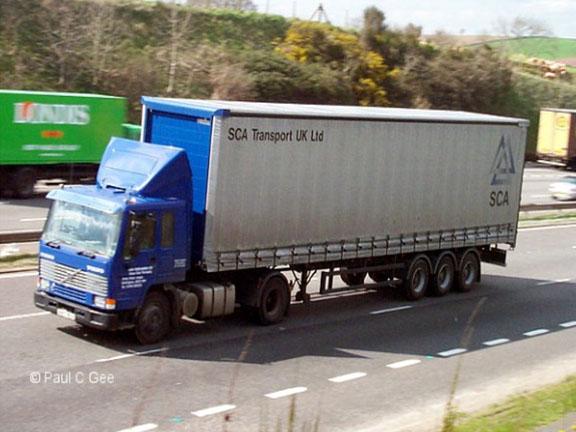Wigan Album
Reeds Corrugated Cases, Goose Green
11 Comments
Photo: Ray Smyth
Item #: 30240
SCA Packaging and SCA Transport in August 1991
Ray, drove one of these 'Wendy house' Volvo vehicles for ASDA some years ago, not a bad little motor but -- they were prone to warning buzzers going off for no apparent reason, could drive you mad on a long run, sharp clout on top of the dashboard usually stopped the Alarm bells for a while.
It's a Volvo FL10, the warning buzzer are more likely to be the front grille open/close device. Fault codes isuse.
Arthur, you were right about the bonnet being a large contributor to the buzzer sounding, I was on the ring road in Nottingham, braking slowly when suddenly the bonnet came fully open, now that did set the alarm bells ringing. However, on this model the alarms seamed to have a mind of their own, a sharp clout was the answer.
JJP,
And we slag off British commercials.
British HGVs WHERE????
Every truck/lorry today has the same technology weather it be British Dutch, Sweden or French etc.
Alan,
Anyone who had an interest would know.
That's just it, I don't have an interest!!!!
However, there is no Full British trucks anymore.
Thats easily remedied -just don't look or comment - move on! ( Common sense really)! Leave them who are interested to enjoy the photos....!
Not a patch on Leyland trucks. We had to keep a couple of older Leyland's at one side to rescue the Volvo's as they were littered with electrical faults.
Well the wagon pictured above is a Scania, not a Volvo, but since Volvo has been mentioned, this would appear to be an appropriate time to mention my own experience of Volvo wagons. I'm calling them wagons as I have an aversion to what I consider to be an invasion of the English language by fashionable American words such as trucks, to give just one example. ( although I'm o.k. with the word rig oddly enough ).
It would appear that Jed has experienced a number of issues with foreign manufactured motors. I'm not doubting him for a moment, as any piece of machinery containing a collection of moving parts is destined to fail sooner or later.... For me, the broms brake in the Volvo could be problematic at times. First off, let me say that the word ' broms ', is Swedish for brake, so broms brake would translate as brake brake....yeah, I know.....secondly, for those amongst us that haven't had the good fortune to experience the joys of a career in road haulage, let me explain the function of the broms brake. The broms brake forms part of the air operated parking brake circuit on Volvo wagons. I've never encountered it on any other vehicle,..ever..,and I've driven one or two over the decades. Now what happens is this. When the air pressure in the braking system air tanks falls below a certain pressure, a knob on the dashboard flirts out,..... how's that for a Wiggin word.. ' flirts '?, that one's definitely going in my revised edition of ' Ozy's dictionary of Wiggin words '.
Anyroad, moving swiftly on, once the knob on the broms brake has ' flirted ' out, the vehicle is immobilised. The brakes are locked on and the thing can't be shifted. Even when the engine is started, and the air pressure in the tanks is allowed to build up to the correct operating pressure of 110 or 120 psi or whatever, the wagon just can't be driven. Not until that is, the knob on the dashboard is pushed back in, then away you go. This must not be considered to be a fault on the manufacturer's part, so much as a lack of knowledge on the driver's.
I got caught out with this many years ago after working a sixteen hour day pulling trailers off the dock at Grimsby, then came home on a ' dodgy ', ...so I wasn't where I was supposed to be, if you don't already get the picture.
The following morning the temperature was well into the minus Celsius range, and although the engine fired up, and the air pressure in all the tanks reached working pressure, and all the warning buzzers shut off, the damn $#%*#€¥ wagon just wouldn't shift.
Suspecting frozen droplets of condensation in the air lines, I went underneath the motor with a blazing diesel soaked rag in an attempt to thaw them out. ( for the uninitiated, wagon driving isn't just about turning a steering wheel and scoffing sausage egg and chips ). Anyway, my attempts at thawing out the air lines were destined to fail, as they weren't frozen in the first place. A difficult phone call then ensued. " have you tried pushing in the broms brake ?"........" What's a bloody broms brake when it's at home?".....
Well, these things happen occasionally, and being of a philosophical bent, I personally consider the experience to be just a minuscule part of life's rich tapestry, but I'm obliged to say that this is the only problem that I recall ever having encountered with a Volvo, and it only happened the one time, and I've piloted some garbage over the past half century. Some of it foreign admittedly, but most of it British, sad to say.
So there we have it, and just in case anyone should be be remotely interested, the name Volvo is the first person singular of the Latin verb meaning ' to roll ', and translates as ' I roll '. It was adopted by the Swedish ball bearing manufacturing company SKF, of which Volvo is an offshoot, as was the male gender symbol seen on the front of Volvo cars and wagons, which is the symbol I believe for Mars, and depicts strength. If I'm not mistaken, it's also the symbol for iron. Anyway, look it up, don't just rely on my say so.
Regards. Ozy.